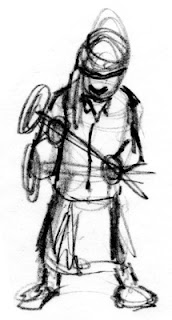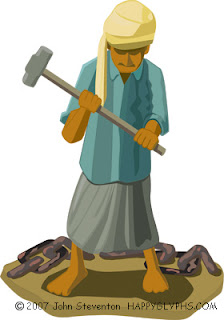When my client called me one night, asking for a magazine cover that showed "the entire city of Shanghai, with the river in front of it, and a bunch of ships going by", well, I didn't know what to say. At first I thought the guy was crazy, and then I thought that I was crazy for considering it.
How the heck was I going to do this, using the technique of vector illustrations, to which I was still relatively new?
The answer, of course, is one step at a time. As the old saying goes, a journey of a thousand miles begins with a single step.... a baby step, even.
There have been a few times in my career when I've seen some great art, and said, "Wow! How the heck could anyone do that? Are they even human?" THe answer is, yes, they're human. They just have a lot of skill, and probably put a lot of time into developing that skill. And, just as important, they had the confidence to start, and complete, something great.
Trust me on this: if you want to survive in this, or any other artistic endeavor, you need some good portfolio pieces. Not something you did in school, unless you graduated in the last six months, and not something you did while watching TV one night.
Thanks to this same client, I've had a few assignments which have taken me nearly a month to complete from start to finish. Not an easy task, especially in this day and age where we want everything right away. Still, you take a deep breathe, and begin.
The above illustration, actually a photograph of the magazine itself, shows the completed work. It took me between 3 and 4 weeks to do, working hours at a time, and using about 40 different photographs for reference. This reminds me, step two, after taking a deep breathe, is to do some research. Today it's easy to run to the internet, but for something like this, 72 dpi just doesn't cut it. Googled images just don't compare to books, magazines, and a good photo morgue.
So, you do some research, and then what? Sketch, sketch, sketch. That's right... get a real pencil and paper if you can find them, and sketch. Sketching on the computer just isn't the same, at least for me.
Once you have a good sketch, you scan it into Adobe Illustrator, and work it up in steps. Block out huge areas of color, determine your light source, place in large structures... just like you learned in art class as a kid. Use basic shapes and colors until you have a well balanced piece.
From there you add enough detail to suit the piece. For this piece I wanted plenty of detail, and at one point I had about 11 layers of details for the city alone. I worked back and forth until an overall balance was achieved, checked my light and shadows, and tweaked the colors for harmony. I didn't stop until I was happy with the work, and trust me, I'm happy.
Fortunately in this case I had plenty of time to work before the deadline, and had no need to rush. For me, this is one of my finest pieces of work, and I would put it against any other magazine cover of its type. I'm very proud, after the fact, and have a terrific portfolio piece to show for all that hard work.

To be honest, though, there were a few days at the beginning when I was pulling my hair out, sweating a bid, and thinking impure thoughts. But that's where the confidence comes in.
Youhave to believe in yourself, take that first baby step, and say to yourself, "I know I can, I know I can..."
Cheers, and let me know what you think, JOHN :0)
PS The original art is even better to see, but I've had too many problems with theft to show any high res stuff on the internet anymore. It's a shame that some people out there have to live their life by feeding off of others, but it is a sorry fact of life.
PSS What's on my iPod today? Bob Dylan, Tangled Up in Blue. The lyrics just slay me.




















